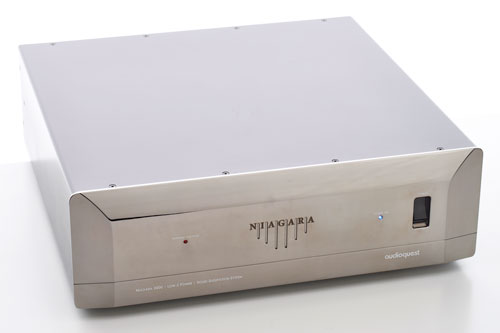The top model of the three mains conditioners is the Niagara 7000, which offers three groups of four sockets each. The first is intended for high current devices and features the so-called "Power Correction" system: this provides a power reservoir for peaks of up to 80 amps (80 for 220v 90 for 110v) with reduced mains impedance for amplifiers that is available at short notice – in milliseconds. This should benefit all power amplifiers, regardless of whether they operate with linear or switched-mode power supplies. The other two groups have isolating transformers with pre-stressed dielectric: the patented AudioQuest technology is designed to significantly reduce non-linear distortion and increase the bandwidth and efficiency of the transformer's noise dissipation. The connected loads are thus supplied with a symmetrical mains voltage of two times 115 volts related to the floating earth. The patented "Ground Noise Dissipation System" is used in all groups: it provides directional ground noise dissipation in six stages. This patented technology is designed to significantly reduce ground noise without compromising safety or creating ground loops at low levels. Garth Powell placed particular emphasis on the fact that the noise dissipation technology is linear over 21 octaves for all three conductors. This guarantees that his power conditioners are effective in all configurations. With conventional conditioners that have many resonance peaks, this is only the case if they coincide randomly with the interference. The mains plug and the sockets of the Niagara 7000 are very low-impedance specimens from the NRG series. The Niagara also provides protection against overload and short-circuit to ground.

The Niagara 5000, which is almost identical in appearance but only half as expensive, is also equipped with the "Power Correction" system for power amplifiers or integrated amplifiers, but has to get by without the balancing isolating transformers and has a solid earth instead of a floating one. Nevertheless, common mode interference from 20 kilohertz to one megahertz is reduced by 30 decibels. The voltage applied to the eight sockets for constant current consumers is freed from interference in four groups by linear noise dissipation systems. Of course, there are low-impedance inputs and outputs as well as protective circuits for overload and short circuits. The surge protection and the high-quality sockets can also be found on the Niagara 1000, which offers one high-current output and two groups with a total of five outputs. Of course the patented "Ground Noise Dissipation System" and the linear "Noise Dissipation System" are also used here.
Before Robert Hay arrived, some boxes with various cables as well as a Niagara 7000 and a 1000 had arrived in my place in Gröbenzell. Robert Hay had received a detailed list with all the components of my system and then selected the cables he deemed to be suitable. We had previously agreed that the cables should meet a high standard, but that they should not be AudioQuest's top products. A one-meter long Tornado costs 1100 Euro, the Dragon costs 4400 Euro. But this would not be in any reasonable proportion to the value of the components for the phono stages, the Melco or the DAC. For the router, the switch, the Aries Femto, the M-Scaler and the heater and the tube power supply for the turntable, Robert Hay had chosen cables of the NRG series.

On a Wednesday in the second half of October the time had come. Robert Hay had arrived the evening before and appeared the next morning in my listening room, full of energy. First, we freed the cables and power conditioners from their boxes in the living room. Otherwise the amount of packaging material would have blocked half of the listening room. Einstein's The Poweramp was the first to benefit from a Tornado. Since the three sockets used to supply the system were occupied, we supplied the Einstein with energy from a socket not previously employed for my system, using the six-meter-long Tornado already mentioned: the power amp now sounded minimally more dynamic and also a little more open than before. In a second step, the Niagara 7000 was used in front of the long mains supply line and made the playback even more lively and dynamic: I was persuaded of the beneficial effect of the "Power Correction" after just a few minutes.


























 |
|

























































































